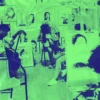Bubblegum pop and novelty music… These two special genres make manifest the incredible power of music by stretching its traditional purpose to fit their own. If music is all about expression, then bubblegum pop is about expressing near-shameless indulgence, and novelty music is about expressing near-mindless mirth.
Here, we’ll take aim at the two in an attempt to justify their existence and (inevitable) resurgence.
What is Bubblegum Pop?
In its strictest sense, bubblegum pop plays to the mental wavelength of kids and teens. As a sub-genre, it’s actually designed to do so.
Artists and audio engineers incorporate mass-marketable techniques into the artistic process. They sacrifice depth for widespread appeal, poignancy for popularity. Such music is manufactured with money in mind and marketed to maximum effect. So, on the face of it, the very concept of bubblegum pop would seem like an insult to the creative process of a ‘true’ musician. But, there’s a bit more to it than that…
Often enough, even the actual musicians hired to produce sounds befitting of a deliberately-funded track are relative unknowns in their industry. One-hit wonders abound in the space and its heyday of the mid-’60s to the early ’70s is fraught with unfamiliar faces.
“Green Tambourine”
Take the Lemon Pipers and their ’68 hit “Green Tambourine” for example. Besides numbering among bubblegum pop’s primordial band and song examples, this one in particular demonstrates quite well the formulaic, Frosted Flakes mainstream approach to music making.
Out of 90 words total, 28 of them are repetitions of “Now listen while I play my green tambourine.” No doubt we were already well aware that pop music can be repetitive. What really places this tune firmly in bubblegum pop territory is its nigh on insulting inoffensiveness. It reeks of safe-play in almost every discernible way. “Drop your silver in my tambourine,” he says. “Watch the jingle jangle start to chime,” he promises.
Without devoting too much time and energy to imagining what chiming jingles and jangles actually look like, let’s also take note of just how many times the exact same statement is expressed with but a subtle change of phrase to set it apart. “Give me pennies, I’ll take anything,” he assures us. “Drop a dime before I walk away,” he warns. All in all, over 16 lines of lyrics, we’re asked to pay up in some form or fashion in 6 of them; a strong testament to the obvious motives belying this music, maybe?
At any rate, the concept of bubblegum pop should be clear here: if you notice your head nodding of its own accord and you’re tempted to spend money on something vaguely musical, you may in fact have gum in your ears. The Lemon Pipers lived and faded away within a 3-year span from ’66 to ’69, but bubblegum went on.
“Sugar Sugar”
If “Green Tambourine” was bubblegum, “Sugar, Sugar” is what bubblegum is made of. Lyrics as silly as “I just can’t believe the loveliness of loving you” serve up a seriously saccharine sound on their own, but The Archies went one step further, incorporating such innocent innuendos as “Oh sugar, pour a little sugar on it honey.” Sexual underpinnings in music mainly marketed at pre-teens may seem a bit lacking in taste, but bubblegum pop kept things upbeat and sweet enough for no one to notice, or at least enough for no one to care. After a four week residence at the top of the singles chart in 1969, “Sugar Sugar” finally stepped down and gave up its crown. The Archies outlived their hit song, but an important point had been proven. Bubblegum pop is designed to infect your mind.
The contrived, manufactured status of bubblegum pop could hardly be more evident than in this ‘band’s’ very existence. They’re 2D animations! Chart-topping 2D animations… Not a live band represented by animations. No, no… ACTUAL animations. Who cares who the singers were? For all intents and purposes, those drawings made the music themselves. It’s every bit as ridiculous as Adventure Time’s Finn and Jake or The Powerpuff Girls dominating the Billboard 100. When fictional folk top charts, suspect bubblegum, and lots of it.
Japanese Bubblegum
Japan’s more endemic take on bubblegum pop places higher emphasis on lolli-level cuteness than anything else. Lyrics, at times, incorporate English in somewhat coherent, but mostly absurd ways and the accompanying videos play a far more significant role in the song’s reception.
Kyary Pamyu Pamyu
Kyary’s unique brand of bubblegum pop plays on Kawaisa or “cuteness” culture, bending its knee to add in a dash of weirdness as well. Even with her intentional weirdness, Pamyu’s music is as bubblegum poptastic as it gets, thanks to songs like “Candy, Candy” that feature lyrics as indulgent as “cutie cutie so candy love.” Bubblegum pop might mostly be about candy, it seems.
“Flamingo”
Although not entirely Japanese, the Londoners of Kero Kero Bonito bring the same Kyary-level weirdness to the world of bubblegum pop in at least one of their tracks. The bilingual bizarreness that is “Flamingo” fuses Pamyu-inspired oddness with dance-worthy synth pop production. Both Pamyu and KKB proudly carry the current generation’s bubblegum pop torch alongside many others, proving it’s definitely still going strong. Novelty music shares a similar story.
What is Novelty Music?
Much like bubblegum pop, novelty songs serve a primary purpose apart from the making of deep, thoughtful music. However, unlike bubblegum pop, they aren’t necessarily in it for the money.
Novelty songs are all about nonsense. They’re meant to be humorous at the least and somewhat enjoyable to listen to at the most. The best of these succeed spectacularly in both areas, the worst, of course, are neither funny nor musically appealing. As a genre, it goes back as far as Frank Sinatra’s 1951 release “Mama Will Bark” and then some. But, it has certainly come a long way since.
Weird Al
Who could eschew the supremely childish novelty antics of the one and only Weird Al? Al’s own take on the genre parodies hits with overtly ridiculous approximations. MJ’s “Beat It” becomes “Eat It,” Chamillionaire’s “Riding Dirty” becomes “White and Nerdy,” Coolio’s “Gangsta’s Paradise” becomes “Amish Paradise,” and so forth. Since his hit album debut in ’84, he’s consistently spat out gag parodies and giggle-worthy originals to relative success. Other acts in novelty music, however, focus entirely on original music, lacing their listens with a whole lot of jokes.
Lonely Island
The SNL-born farcical rap trio known as The Lonely Island play to novelty music’s most common effects through faux-serious songs riddled with utterly ridiculous antics. Tracks like “Jizz in my Pants” aim squarely at listeners’ funny bones, but inflict reasonable collateral damage on their eardrums as well. Comedic topics span the gamut from the sexual to the supernatural and, occasionally, the arguably criminal. Rap and hip-hop make up the majority of their output; likely due to such styles aligning closely with traditional standup comedy in a shared emphasis on the spoken word. Cameos aren’t uncommon in their songs either, including high profile artists and actors keen to crack jokes on a track. But, the Lonely Island aren’t the only ones to go this route. Other artists walk a similar line with considerable skill.
Lil Dicky
Lil Dicky’s take on novelty music is similar to Lonely Island’s, pairing hip hop with unbridled tomfoolery to get a rise out of listeners. His first viral release, “Ex Boyfriend,” coaxes out laughs with lines as tragically humorous as “the physics of his dick just don’t make any sense.”
His song “$ave Dat Money” flips the flexing script of rap vids for entertainment, with Fetty Wap on the chorus and Rich Homie Quan in a cameo. As is the case with most novelty music, the visual matters as much, if not more so than the audible in Lil Dicky’s songs. His videos play on comical premises, placing him in humorous mundane moments and ridiculous, supernatural storylines alike.
“Freaky Friday,” his 2018 hit with Chris Brown, sees the two (and a few more) switch bodies to ensuing hi-jinks.
Where bubblegum pop paints its cutesy picture of life and music in the rosiest tint and shallowest depth to the beat and skip of impending profit, novelty music eschews profit potential, seriousness, and, in some cases, even actual musicality for the fun of it. But should either of the two make a comeback dash to mainstream prominence? Well, yeah.
Resurgence or Rediscovery?
The long and short of it is that neither is going anywhere soon. Novelty music has been around in some form or fashion likely since the dawn of music and time immemorial. If you close your eyes and imagine it, you can almost hear the bones and coconuts cracking on a man’s skull to riotous laughter. Bubblegum pop, though newer, won’t be giving up the ghost for a good while either, if ever. Mass-producible mindless music makes money and money makes more mass-producible mindless music. See the cogs a-turnin’?
Both genres are always up for resurgence because they’re always around, waiting for the right someone to pick up on them and parade them about like the great, gaudy show-horses they are. Sure, their appeal ebbs and swells with the period, but they’ve never really gone away. And for a great many reasons, quite a lot of us wouldn’t want them to.
.FEATURED IMAGE: LIL DICKY




